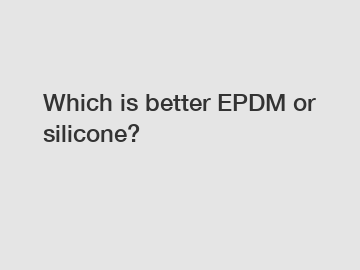Which is better EPDM or silicone?
When it comes to choosing the right material for your sealing and insulation needs, there are a plethora of options available on the market. Two popular choices that often come up in discussions are EPDM and silicone. These two materials are widely used in various industries due to their unique properties and benefits. But which is better - EPDM or silicone? Let's delve into the characteristics of each material to help you make an informed decision.
EPDM, or ethylene propylene diene monomer, is a synthetic rubber material that is known for its excellent weather resistance and durability. It is commonly used in roofing applications, automotive seals, and as a gasket material due to its ability to withstand exposure to ozone, sunlight, and extreme temperatures. EPDM is also highly flexible and has good abrasion resistance, making it suitable for applications where movement or flexing is involved.
On the other hand, silicone is a versatile elastomer that is known for its high thermal stability, excellent electrical insulation properties, and resistance to chemicals and aging. Silicone is often chosen for applications that require high temperature resistance, such as in automotive engines, electronics, and food processing equipment. It is also known for its non-stick properties, making it ideal for use in sealing and molding applications where release properties are important.

In terms of weather resistance, EPDM is known to be superior to silicone. EPDM has excellent resistance to UV radiation, ozone, and weathering, making it a preferred choice for outdoor applications such as roofing and automotive seals. Silicone, while still resistant to UV radiation, may experience degradation over time when exposed to harsh outdoor conditions. Therefore, if your application requires long-term outdoor exposure, EPDM may be the better choice.
When it comes to temperature resistance, silicone outperforms EPDM. Silicone can withstand temperatures ranging from -60°C to 230°C, making it ideal for high-temperature applications where EPDM may fail. Silicone also maintains its flexibility and elasticity over a wide temperature range, whereas EPDM may stiffen or become brittle at extreme temperatures. If your application requires high-temperature resistance, silicone may be the more suitable option.
In terms of chemical resistance, silicone is known to be more resistant to a wider range of chemicals compared to EPDM. Silicone exhibits excellent resistance to acids, alkalis, solvents, and other chemicals, making it a preferred choice for applications where exposure to harsh chemicals is common. EPDM, while still resistant to many chemicals, may not be as versatile as silicone in terms of chemical compatibility. Therefore, if your application involves exposure to chemicals, silicone may be the more suitable choice.
In terms of flexibility and compression set, EPDM is known to be superior to silicone. EPDM has excellent flexibility and can withstand repeated compression and expansion without losing its shape or sealing properties. Silicone, while still flexible, may experience deformation or compression set over time, especially under high-pressure or high-temperature conditions. Therefore, if your application requires a material with good flexibility and compression set resistance, EPDM may be the better option.
In conclusion, both EPDM and silicone have their unique properties and benefits that make them suitable for different applications. If your application requires superior weather resistance and flexibility, EPDM may be the better choice. Conversely, if your application requires high-temperature resistance and chemical compatibility, silicone may be the more suitable option. Ultimately, the choice between EPDM and silicone will depend on your specific application requirements and the environmental conditions in which the material will be used. It is recommended to consult with a materials expert or supplier to determine the best material for your sealing and insulation needs.
For more information, please visit 4 inch ductile iron pipe price, centrifugally cast ductile iron pipe, 150mm ductile iron pipe.
162
0
0


Comments
All Comments (0)